
Maximize Your Wi-Fi Experience: Boosting Signal in Every Corner
In today’s hyper-connected world, where streaming, online gaming, and remote work dominate our lives, the demand for a reliable Wi-Fi connection is more essential than ever. A weak signal can severely impact our ability to connect with the digital world, effectively transforming how we navigate our daily tasks. Here are practical strategies to boost your Wi-Fi signal throughout your home, ensuring seamless connectivity.
1. Optimal Router Placement: Find the Sweet Spot
The location of your router plays a crucial role in determining the strength of your Wi-Fi signal. Ideally, place your router in a central location within your home, away from thick walls and electronic devices. This allows for better distribution of the signal and minimizes obstructions.
2. Upgrade Your Router for Enhanced Capabilities
If your router is several years old, it might be time for an upgrade. Modern routers equipped with dual-band or tri-band technology can help eliminate congestion and improve range. Additionally, enabling the latest Wi-Fi standard, such as Wi-Fi 6, ensures you get the best performance available.
3. Utilize Range Extenders or Mesh Networks
For larger homes or areas with dead zones, consider investing in a range extender or a mesh network system. These devices work to amplify your existing signal, effectively extending coverage and improving overall performance.
4. Update the Frequency for Less Interference
Most routers default to the 2.4 GHz frequency, which is often crowded with signals from neighboring networks. Switching to the 5 GHz band can reduce interference and deliver faster speeds, leading to a better online experience.
5. Secure Your Network to Prevent Unauthorized Access
Without proper security measures, your network may be accessed by unauthorized devices, slowing down your Wi-Fi speed. Ensure you use a strong password and enable encryption protocols to protect your network.
6. Invest in Quality Equipment: Antennas Matter
Some routers come with adjustable antennas designed to enhance signal strength. If your router has external antennas, experiment with their positioning to optimize coverage. For those looking to significantly boost reception, purchasing high-gain antennas may provide additional benefits.
7. Manage Connected Devices: Keep Essential Connections Active
Too many devices connected to your network can slow things down. Regularly review which devices are currently connected and manage the number of active connections to prioritize bandwidth for essential activities like streaming or video calls.
8. Minimize Interference from Electronics
Other electronic devices, such as microwaves and cordless phones, can interfere with your Wi-Fi signal. Position your router away from such devices and consider relocating electronics that may be causing interference.
9. Regularly Reboot Your Router for Optimal Performance
Just like any device, routers can benefit from regular reboots. Simply disconnecting it from power for a minute and reconnecting can resolve issues and improve connectivity.
10. Monitor Your Internet Speed
The performance of your Wi-Fi connection shouldn’t solely depend on your equipment. Use speed testing tools to assess your internet speed and compare this with what your service provider promises. If issues persist, it may be necessary to contact your ISP for assistance.
Conclusion: Stay Connected Effortlessly
Implementing these strategies can greatly enhance your connectivity at home, ensuring you have a dependable Wi-Fi experience. With the rise in online activities, understanding how to strengthen your Wi-Fi signal benefits not only personal use but also supports productivity for remote work, gaming, and more.
 Add Row
Add Row  Add
Add 




Write A Comment